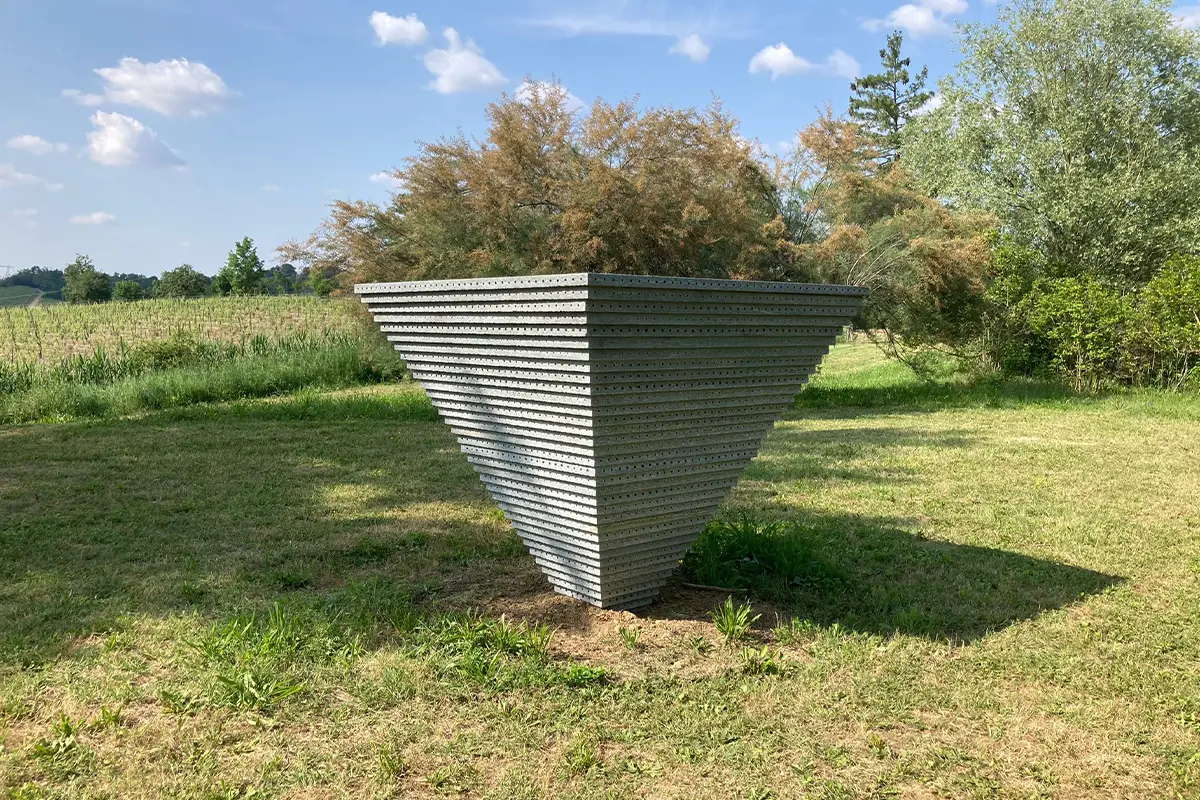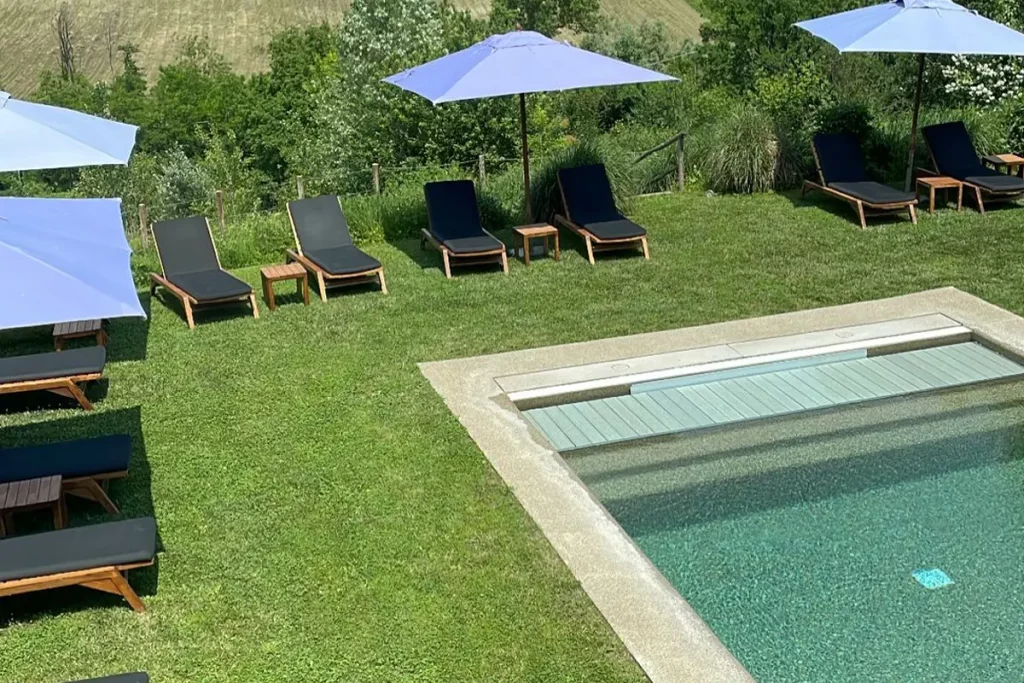«Tami Izko at La Raia focused on the theme of biodiversity and wanted to emphasize the compromised ability to look at, and systematize what surrounds us»
The concept of biodiversity dates back to 1985 as a contraction of biological diversity and is comprised of several levels, such as genes, species, and entire ecosystems, where life interplays with the environment. Over history, biodiversity has changed and flowed, and extinction rates increased as human populations grow.
Promoting biodiversity, on the other side, can improve the cycles of nature, valuing the work of humans that inhabits the environment – and this is indeed what happens in Fondazione La Raia, which was born in June 2013 to promote, in Italy and abroad, a reflection on the landscape understood in all its components – geographical, social, agricultural, and cultural.
Fondazione La Raia: promoting biodiversity through Art
Fondazione La Raia develops themes consistent with the approach that the Rossi Cairo family has given to the homonym biodynamic farm over the past two decades, working in sync with the Gavi’s environment.
Here, crops are grown according to biodynamic principles, and the commitment is to protect and promote the biodiversity of a farm that has forests, vineyards, cultivated fields and meadows, lakes, gardens, an orchard and many hedges that provide shelter for small animals.
In the past ten years, the natural theme has been a core issue for La Raia, which has dedicated ten works by international artists to the environment and biodiversity. The works are visible every month of the year, presented with events open to local communities, institutions, and schools.
The activity started back in 2013, with the Nel Paesaggio project: artists, philosophers, agronomists, photographers, and architects were invited to live and experience the vineyards, fields and woods of La Raia, and offered, through interventions and works of art, opportunities for knowledge and a new identity around Gavi.
Tami Izko Inventory at Fondazione La Raia
Inventory is the new site-specific project created by Tami Izko for Fondazione La Raia, which celebrates its tenth anniversary in 2023. An inventory – she explained – is a list of things collected, and chosen, the register on which we jot down what we find.
A small cave along the driveway from the winery becomes the space in which to store the individual tiles, the pixels of the landscape of this biodynamic estate in the Gavi. The materials chosen for the works, as well as elements found on the land, go through a process of transformation in which they move away from the natural world to evoke it through absence.
Tami Izko’s sculptures as a chamber of wonders in the territory
The creation of each piece stems from a specific cast, which was filled with liquid porcelain. Some pieces, on the other hand, were created by hand by the artist in stoneware in order to play with size and shape. Each sculpture was then glazed using a pastel color palette and then fired at 1250 degrees. When asked about the choice of ceramic, Izko explained: «Porcelain and stoneware are very present in my practice. Besides their characteristics that make them weather resistant, I also like that they are fragile yet resilient materials. The colors, aside from being my usual palette, have a connotation that encourages the viewer to approach Inventory playfully and open to being impressed with small details».
All these objects create a catalogue, and a list of gathered things. An exercise that helps not only to put things in order and to observe more carefully, but also to communicate to the visitor that Izko has experienced the Raia landscape and paused in front of a cave on the driveway, imagining it as the chamber of wonders of her personal selection of this territory, in her inventory of the surrounding space.
Natural details against digital scenarios at Fondazione La Raia
The work consists of thirty two sculptures made of glazed porcelain and stoneware, some floating on the small body of water that is turned into a fountain. These works evoke elements from Raia’s plant world: vine trunks, lake reeds, pinecones, walnut shells, acorns, bunches of grapes, shells and shrubs, and elements from the working world of the company and the people who live there: shoe soles, plastic cables, portions of work clothes.
And indeed, what inspired the project has been the awareness that living in a fast-paced context, immersed in technology and digital scenarios somehow compromises our ability to see the world and makes us forget the little details. Tami Izko, when asked, states that this was at the heart of her project: «to push the viewer to take a closer look and focus on the details that often escape our sight. No piece chosen for this project is spectacular, not even the place where the work was finally installed. The grotto is hidden at the entrance of La Raia Foundation, so you have to make the effort of finding it and once there, of looking at the thirty two sculptures embedded within it. This also requires patience, a trait necessary to grasp the fragility and the complexity of that which surrounds us».
Intending to engage visitors in an exercise of observation, Izko has turned this cave into the Inventory of the Surrounding Space, the nutshell where elements reinterpreted in porcelain and ceramics have been abstracted from their context.
Biodiversity and the absence of things at Fondazione La Raia
Tackling biodiversity through art means – according to Izko – speaking of «the abundance of details spread throughout La Raia’s territory and the importance of the human presence in making this place what it is». The cave recalls such coexistence, where sculptures made of different elements are now showcased together, representing the core idea of biodiversity, which for Izko «means a wide variety of elements that coexist in an ecosystem in balance. If some of those elements are removed or modified, that symphony becomes dissonant, eventually falling apart. Each piece in Inventory was placed in the cave respecting a visual balance with the rest of the works and the natural inhabitants of the cave. It’s a subjective balance in this sense, but allegorical of the equilibrium required for all things to be».
Each piece showcased in Inventory is based on a naturally occurring element or the human traces found in La Raia – a wire, a piece of cloth, or a shoe sole. «Those are the structures of the works I then made» explains Izko «and which remove themselves from the natural or human details they are reminiscent of. What ties them is a process of correspondence and transformation».
According to the idea of biodiversity, human, plants and animals find a common space in the environment: Inventory here «is more than a wunderkammern, where the ‘exceptional’ is collected, ordered and displayed, in line with a colonial attitude based on extraction and labelling for the exotic. In Inventory, the things already preexisting in the space are highlighted to lead viewers into an act of careful observation» states Izko.
Different approaches at La Raia: sculpture, photography and sounds
As Izko explains, she worked on Inventory using a ‘photographic approach’, collecting things that she then turned into molds, to cast them and turn them into new objects. «This method of mold-making was very much like taking a picture. I then decided to add a layer which was that of sound: if I was doing a visual recollection why not include a sound one?» As biodiversity tackles different species living in an environment and the relationships within them, Inventory is made of different languages, and different form of arts and expression.
That’s how Davide Cairo worked on a piece based on sounds gathered in La Raia and then transformed it in relation to the sculptures that make up Inventory. «There was a third and final layer that closed the circle which was that of turning the installation into a single image» states Izko. Federico Clavarino made, in fact, a large format picture of this work that is now visible at La Raia’s Locanda.
According to Ilaria Bonacossa, Artistic Director of Fondazione La Raia, Tami Izko’s project promotes the Foundation’s mission: to involve artists from different areas who are able to cast their critical gaze on the Gavi landscape, creating new opportunities for reflection and awareness on what is natural. «In her Inventory, Izko focused her gaze on the theme of biodiversity and wanted to emphasize the compromised ability to look at, observe, and rationalize what surrounds us».
Tami Izko
Tami Izko was born in Bolivia, in 1984, and came to sculpture, and particularly ceramics, when she lived in Lisbon. Like her texts, the ceramic objects she makes are often related to the representation of self. Her works have been exhibited in Geneva, London, Schöppingen, Brussels, Istanbul, Milan, and Turin.




















